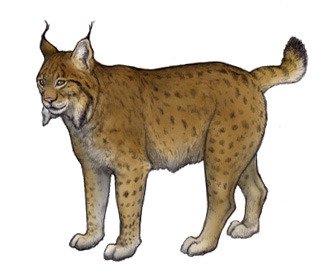
The Eurasian lynx, known scientifically as *Lynx lynx*, is a remarkable species found across various habitats in Europe and Asia. As we reflect on its history, we’ll uncover how this cat evolved not just to survive, but to thrive in diverse environments. Think of it as a story of resilience—one that has sculpted the lynx into the stunning creature we know today.
Origins of the Lynx Family
The story of the Eurasian lynx starts millions of years ago. The lynx belongs to the family Felidae, which is the same family that includes lions, tigers, and domestic cats. The Felidae family split into different lineages about 10 to 15 million years ago. The earliest ancestors of the lynx are believed to have originated in North America before migrating to Europe and Asia.
As these ancestors adapted to their surroundings, they underwent significant changes in size and features. Ancient felids had traits like long legs and powerful bodies, which helped them hunt effectively in varying terrains. Over time, the members of the lynx family—*Lynx rufus* (bobcat), *Lynx canadensis* (Canada lynx), and our star, the Eurasian lynx—began to differentiate based on their geographic locations and the climates they lived in.
Adaptations to the Environment
One of the most impressive aspects of the Eurasian lynx is its remarkable adaptability. These cats have evolved to thrive in cold, snowy climates as well as in more temperate regions. The lynx sports a thick, luxurious coat that not only keeps it warm during harsh winters but also helps it blend into its forest surroundings. Picture a snow-covered landscape, and then imagine a lynx gracefully moving through the trees, almost invisible.
Physical adaptations like larger paws act as natural snowshoes, allowing the lynx to traverse snowy terrains with ease. This adaptation is crucial for hunting in the winter months when prey is harder to find. From its keen eyesight to its acute sense of hearing, every feature of the Eurasian lynx has evolved to enhance its hunting prowess. It’s like a well-tuned instrument, perfectly designed for the symphony of the wild.
Prey and Hunting Strategies
Hunting is central to the life of the Eurasian lynx, and its evolution has closely intertwined with that of its prey. These cats primarily hunt small to medium-sized ungulates, such as deer and rabbits. Their hunting strategy is fascinating; they rely on stealth and patience. Imagine a lynx lying low in the underbrush, waiting for just the right moment to pounce.
Eurasian lynxes have developed sharp retractable claws and strong jaws, making them effective hunters. They use their keen sense of sight and hearing to detect movement from far away. Interestingly, they’re also solitary animals, which means they often hunt alone rather than in packs, relying on their skills to catch food. This solitary nature is a key aspect of their survival strategy, allowing them to be stealthy and efficient while hunting.
Evolutionary Challenges and Threats
Despite their impressive adaptations, the Eurasian lynx has faced several evolutionary challenges. Habitat loss, thanks to human encroachment and deforestation, has significantly impacted their population. As forests shrink and prey becomes scarce, lynxes find it harder to thrive. You might be wondering how these challenges shape their history. Well, just like many species, the Eurasian lynx has had to adapt to these growing pressures.
The last few centuries have seen a dramatic decline in the lynx population due to hunting and habitat destruction. However, their resilience shines through. Various conservation efforts have been launched to protect them, allowing populations to slowly recover in some areas. These efforts play a crucial role in ensuring that the lynx can continue its evolutionary journey, adapting even in the face of adversity.
Modern Conservation Efforts
Conservation of the Eurasian lynx is vital not just for the species itself, but also for the health of the ecosystems they inhabit. These cats play an important role as apex predators, helping to maintain the balance of wildlife populations. Various organizations are working to protect their habitats, promote coexistence with humans, and raise awareness about the importance of preserving this magnificent species.
Some of the most successful programs focus on habitat restoration and creating wildlife corridors, which allow lynxes to move freely between areas. This is crucial for genetic diversity and overall health of their populations. Imagine a highway for wildlife; that’s what these corridors represent. By reversing some of the damage done by urbanization, we can help ensure that the future of the Eurasian lynx is bright.
The Future of the Eurasian Lynx
Looking ahead, the future of the Eurasian lynx will depend on continued conservation efforts and public support. Enhanced awareness about their role in the ecosystem can inspire communities to protect their habitats. Ecosystem health is interconnected, and by saving the lynx, we contribute to the health of entire forests and landscapes.
As more regions adopt measures for sustainable land use and wildlife protection, it’s encouraging to see populations of lynxes rebound in various areas. Here’s the thing: every little effort counts. If more people understand the challenges faced by the Eurasian lynx, we can collectively work towards a future where these beautiful cats roam freely across their ancestral lands.
In summary, the evolutionary history of the Eurasian lynx is a captivating tale of adaptation, resilience, and survival. From their origins millions of years ago to the modern challenges they face today, these fascinating creatures remind us of the complexity of nature and the importance of conservation. As we take care of our environment and support wildlife protection, we ensure that future generations will also get to admire the grace and power of the Eurasian lynx. Just like the journey of this elusive feline, our efforts can leave a lasting mark on the world around us.
